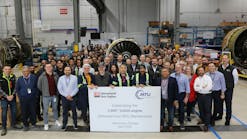"Learning the secret of flight from a bird was a good deal like learning the secret of magic from a magician." -- Orville Wright
As the nocturnal owl stalks its prey, a quirk on its wings enables a silent hunt. Fringe-like feathers hang off the bird and muffle the whooshing air. Even a sharp-eared mouse can't hear the owl swoop in.
That lesson in aerodynamics provides a valuable guide for aviation experts who are crafting a new technology. They've incorporated the concept into the Silent Aircraft Initiative, a plan to create a plane that would make no noticeable noise outside an airport.
It has been more than 100 years since the Wright brothers first took flight. Since then, humans have invented jet engines, shattered the sound barrier and created an airline system so safe that accidents have nearly been eliminated.
But as scientists attempt to improve planes of the future, they are finding that super computers and aerodynamic theory are often no match for nature. The breeding ground of natural selection has improved flying creatures over millions of years, creating a virtual test bed of clever solutions to aerodynamic problems, according to some of the top experts in aviation.
"It's not just strapping wings on and jumping off a cliff," says James DeLaurier, a professor emeritus at the University of Toronto who spent decades studying flapping wings. "It's respectable to look at nature for inspiration. We don't come close to doing all the things that nature does."
In labs around the world, biologists and aerodynamicists are studying birds, bats, insects and even extinct flying dinosaurs for new ideas:
*NASA and the military have funded extensive research into planes that mimic birds' ability to shift the size and shape of their wings. The work promises to create aircraft capable of far more versatile and efficient flight.
*Birds, bats and other creatures have millions of nerves in their wings that sense minute shifts in winds, allowing them to save precious energy and to maneuver far more nimbly than any human-designed aircraft. NASA and other research groups are experimenting with flying machines that have computer-driven sensors to do the same thing.
*Living creatures that fly have elaborate natural systems to monitor their health, and to repair themselves after suffering injuries. Aerodynamic experts believe that adopting such techniques in flying machines will make them safer and more reliable.
*Scientists in Toronto led by DeLaurier last year succeeded in building a contraption envisioned by people for thousands of years: an aircraft that carried a human aloft by flapping its wings. The creators say the technology will never replace jetliners, but it has expanded the understanding of aerodynamics and can be used for small, unmanned aircraft.
John McMasters, an aerodynamics expert at jet manufacturer Boeing, has taught aircraft design for 40 years. "One of the rules is never invent anything you don't have to," McMasters says. "If you can find a precedent that solves a problem, use that."
Longtime fascination with birds
Humans have been fascinated by how birds fly since the dawn of history. Leonardo da Vinci, the Italian painter and scientist, studied birds in the 15th and early 16th centuries, drawing a detailed plan for a glider with bird-like wings. Wilbur and Orville Wright studied birds as they developed their airplane, which flew on Dec. 17, 1903.
But many early designs copied from birds failed, according to Terry Weisshaar, an aeronautics professor at Purdue University. The problem was that early flight pioneers often copied bird wings without understanding the underlying principles that made them work.
As aircraft designers developed better tools and built more sophisticated planes, they turned away from birds. "I think the feeling from the pioneers was, 'We are doing better than nature,'" DeLaurier says.
In recent years, however, two developments renewed the aviation world's interest in nature, says Anna McGowan, head of aerodynamics technology at NASA's Langley Research Center.
Increasingly radical designs
First, growing computer power has allowed designers to experiment with increasingly radical aircraft designs that humans by themselves would have difficulty controlling. Computers can replicate the sophisticated control mechanisms in birds and bats.
Secondly, aircraft designers are no longer forced to build high-performance aircraft out of rigid metal.
There is another reason for the change, says Oxford University research fellow Graham Taylor, who is studying birds and insects. The simplest problems in aviation have mostly been solved. The issues that remain are far more difficult. "But natural selection has already done much of the brute computation for us by solving problems evolutionary," he said in an e-mail.
The field is burgeoning with discovery, according to interviews with a half-dozen of the world's top experts. The work is key to developing solutions to growing environmental concerns over noise and global warming, they say.
Scientists want to know how birds can fly without the large vertical tail fin required on virtually every plane. Getting rid of the tail could save fuel.
They are trying to figure out how insects can buzz around for hours, fueled only by leaves. "They run on bug juice. How do they get that metabolism going? They gnaw on a leaf and fly around," DeLaurier says.
McMasters says the public shouldn't expect to see planes that look like a dragonfly or an owl any time soon, but lessons learned from nature will play an increasing role in new aircraft.
"It's plagiarism if you copy a term paper, but it's absolute good design if you copy nature," says Perdue's Weisshaar. "Nature doesn't have a copyright."





